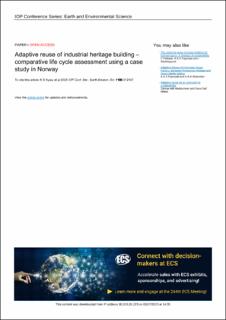| dc.description.abstract | Materials production dominates the total Greenhouse gas (GHG) emissions in the construction industry. On the other hand, most existing building stocks are expected to last for the next 30 years, which can contribute to increasing resource efficiency, reducing environmental impact, and creating social, cultural, and economic values for society. Therefore, it becomes vital to investigate the environmental impacts of adaptive reuse of existing buildings using a life cycle approach. The objective of this study is to explore the environmental performance of adaptive reuse of an industrial heritage building compared to new construction using a life cycle assessment (LCA) method. The environmental impacts of the selected case study are evaluated using four scenarios, with two adaptive reuse scenarios, a warehouse or an office building and two new construction scenarios, a new warehouse or a new office building. One-Click LCA is used as an LCA tool, and the scenarios are compared by total carbon footprint, life cycle models, GHG emissions per building elements and material types. The results show that among the four scenarios, the adaptive to warehouse scenario is the best adaptation option with considerably lower environmental impact, followed by the adaptive office scenario. This paper highlights that adaptation of existing industrial heritage buildings, with the least materials replacement option, is worthwhile. The further evaluation needed for the study's limitation is also highlighted for data efficiency and potential for further research. | en_US |

